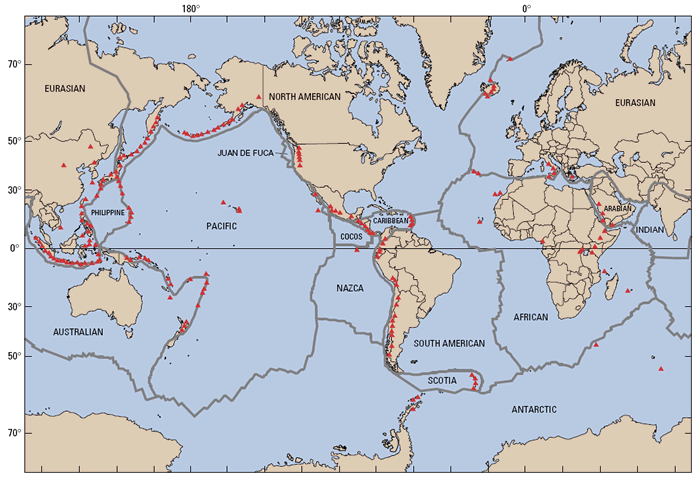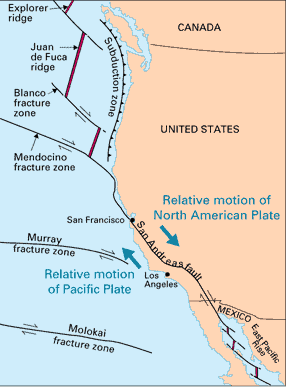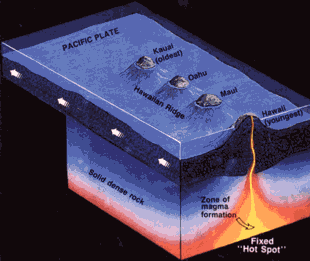Plate tectonic theory: The Essential low down
Volcano Learning Zone > Plate Tectonics>
 Plate Tectonics and volcanoes are closely linked and most of the worlds volcanoes occur along the earths plate boundaries. Plate Tectonic theory explains how the heat generated within the earths interior causes volcanoes,earthquake, breaks up continents and causes continents to collide again. Beneath our feet the earths crust is sliding around on the hot rocks of the earths interior. Here's how?
Plate Tectonics and volcanoes are closely linked and most of the worlds volcanoes occur along the earths plate boundaries. Plate Tectonic theory explains how the heat generated within the earths interior causes volcanoes,earthquake, breaks up continents and causes continents to collide again. Beneath our feet the earths crust is sliding around on the hot rocks of the earths interior. Here's how?
The earths crust is split into large rigid slabs of rock called tectonic plates. The slabs are the cooled outer layer of the earth and beneath them the lies the mantle, a very hot layer of rock on which the plates float. Beneath the mantle is the earths core which generates vast quantities of heat. The heat causes convectoin currents which move the earths plates around.
There are 4 types of plate margin but only 2 produce volcanoes, destructive margins or subduction zones and Constructive margins or Mid Ocean Ridges. The Volcanoes which emerge from the sea or erupt on land are shown as red triangles .The mid ocean ridge volcanoes are located at submarine constructive plate boundaries.They converge,diverge slide over and under each other creating earthquakes, volcanoes and mountain ranges in the process. It is at these plate boundaries that most volcanic activity occurs.
USGS Plate Tectonics in a Nutshell
USGS: Understanding Plate Margins
USGS : What drives the plates?
Earths Cross section
 The cross section through the earths crust. The earths tectonic plates, which make up the earths crust, float upon the hot rocks of the mantle below. Although solid the mantle moves due to enormous convection currents caused by the heat from the earths core. The mantle flows in a"plastic" manner a little like warm plasticine - solid but can move!
The cross section through the earths crust. The earths tectonic plates, which make up the earths crust, float upon the hot rocks of the mantle below. Although solid the mantle moves due to enormous convection currents caused by the heat from the earths core. The mantle flows in a"plastic" manner a little like warm plasticine - solid but can move!
Oceanic crust is created at the mid ocean ridges and then travels towards the subduction zones where it sinks back into the mantle.
Subduction Zones or destructive margins

Explosive volcanoes occur at subduction zones. As Oceanic crust moves away from the mid ocean ridges it gets colder and more dense. Eventually it will sink back into the mantle. As it sinks back into the mantle fluids are released which cause melting in the wedge of mantle above. The molten rock gradually rises towards the surface through cracks and weaknesses in the crust above. Eventually it collects in a magma chamber from which it then erupts as a volcano.
The magma the volcano produces will be quite "sticky" or viscous due to high levels of silica picked up from the crust on the ascent and from fractional crystallisation.
This is where more siica rich minerals crystallise out first as the magma cools in the magma chamber.
Subduction can occur beneath another oceanic plate or beneath a continental margin. Subduction zone volcanoes are often called strato-volcanoes or composite volcanoes because they erupt a mxture of lava an ash. Eruptions are usually explosive. The Andes give their name to Andesite the rock type which is the predominant volcanic rock type. Rhyolite,Dacite and occasiionally basalt are also erupted.Constructive margins and mid-ocean ridges
 Most of the worlds volcanic activity is hidden beneath the earths ocean s along mid-ocean ridges or constructive margins.
Along this boundary the worlds oceanic crust is created from a long chain of underwater volcanoes.
When two plates pull apart magma from the mantle wells up to fill the gap. As the crust moves away from the ridge the ocean becomes wider.
Most of the worlds volcanic activity is hidden beneath the earths ocean s along mid-ocean ridges or constructive margins.
Along this boundary the worlds oceanic crust is created from a long chain of underwater volcanoes.
When two plates pull apart magma from the mantle wells up to fill the gap. As the crust moves away from the ridge the ocean becomes wider.
Occasionally this ridge emerges from the ocean (Iceland) where a hot spot is also present. Where spreading occurs under a continent such as The East African rift a rift valley dotted with volcanoes occurs. If spreading continues then a new ocean will form.

Iceland lies astride the Mid Atlantic Ridge wich runs down the centre of Atlantic ocean from the Arctic to the Southern Ocean. The Atlantic Ocean is widening at a rate of 5-10 cm /year. Iceland was where the North Atlantic ocean first opened during the tertiary period as the underlying Hot Spot welled up and split Europe away from Greenland and North America. Europe and North America have been getting further apart ever since!
Conservative plate margins or strike slip (transform)
 Volcanoes do not occur along conservative boundaries. Plenty of earthquake action though!
This is where two of the earths plates slide past each other very slowly.
The movement is not smooth and the plates stick. Eventually the plates release and the energy travels through the earths crust as seismic waves - an earthquake.
Volcanoes do not occur along conservative boundaries. Plenty of earthquake action though!
This is where two of the earths plates slide past each other very slowly.
The movement is not smooth and the plates stick. Eventually the plates release and the energy travels through the earths crust as seismic waves - an earthquake.
The San Andreas fault occurs where the North American Plate moves south against the northward movement of the Pacific plate. 
Collision zones and mountain building
 The sediments from the ancient ocean form the highest peaks of the Himamlayas. Mt. Everest is largley composed of limestone formed from the remains of billions of fossilised sea creatures.
Collision zones occur where two continents collide.
The sediments from the ancient ocean form the highest peaks of the Himamlayas. Mt. Everest is largley composed of limestone formed from the remains of billions of fossilised sea creatures.
Collision zones occur where two continents collide.
Before the continents can collide a subduction zone will have consumed all the oceanic crust in between them. The continents will have drawn closer together until no ocean exists any more.
The continent on the plate that was subducted will be dragged under the leading edge of the other continent. Continental crust is bouyant and cannot be fully subducted but it can be wedged under.
 The sediments from the lost ocean are scraped off and thrust upwards to form mountains such as the Himalayas.
Once the subduction process is over then volcanic activity is rare but can occur when the crust becomes so thick that the bottom melts and rises to the surface.
The sediments from the lost ocean are scraped off and thrust upwards to form mountains such as the Himalayas.
Once the subduction process is over then volcanic activity is rare but can occur when the crust becomes so thick that the bottom melts and rises to the surface.
Hot Spots and Mantle Plumes and Intra Plate Volcanoes

Not all volcanoes occur at the edges of plates. Intra-plate or hot spot volcanoes occur away from plate margins where a hot jet or plume of hot mantle pierces the overlying crust. As the plate moves over the top of the plume a chain of volcanoes is created.Volcanic activity is usually effusive and basaltic where plumes pierce oceanic crust. Where plumes are trapped beneath continental crust Supervolcanoes such as Yellowstone can occur. A mantle plume underlies Iceland on its mid ocean ridge location, which gives an extra push to the volcanism here and allows Iceland to rise above the waves.
The current activity in Hawaii is under Big Island as this is where the Hot Spot is. The other Islands of Hawaii have little or no activity. To the West of Hawaii lies a long chain of seamounts or eroded volcanoes which were originally over the Hot Spot. Yellowstone is an example of Hotspot underneath continental crust. The Hot Spot here has created a Supervolcano.


